
Wildeck Castle or Wildeck Palace (German : Schloss Wildeck) is an old hunting lodge in Zschopau in Saxony. It stands on a rocky spur above the River Zschopau.

Wildeck Castle or Wildeck Palace (German : Schloss Wildeck) is an old hunting lodge in Zschopau in Saxony. It stands on a rocky spur above the River Zschopau.
The site today forms an irregular triangle, the narrow wing of the castle surrounding the courtyard, with its bergfried known as Dicker Heinrich or "Fat Henry", faces the River Zschopau; the side facing the town is sealed by a wall. The staircase tower in the corner of two wings is called Schlanke Margarete or "Skinny Margaret".
| Wikimedia Commons has media related to Wildeck Castle . |
Coordinates: 50°44′44.6″N13°04′06.8″E / 50.745722°N 13.068556°E
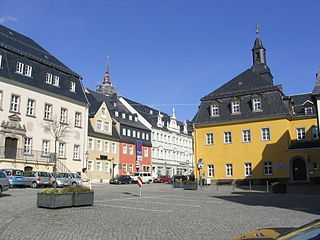
Zschopau, is a town in the Erzgebirgskreis district of Saxony, Germany.

Schloss Ringberg is located in the Bavarian Alps, 50 km south of Munich, on a foothill overlooking the Tegernsee. Not open to the general public, it is a property of the Max Planck Society and used for conferences.

Schloss Köpenick is a Baroque water palace of the Hohenzollern electors of Brandenburg which stands on an island in the Dahme River surrounded by an English-style park and gives its name to Köpenick, a district of Berlin.

Princess Marie Agnes Henriette of Hohenlohe-Langenburg, full German name: Marie Agnes Henriette, Prinzessin zu Hohenlohe-Langenburg was a member of the House of Hohenlohe-Langenburg and a Princess of Hohenlohe-Langenburg by birth. Through her marriage to Constantine, Hereditary Prince of Löwenstein-Wertheim-Rosenberg, Agnes was also a member of the House of Löwenstein-Wertheim-Rosenberg and Hereditary Princess of Löwenstein-Wertheim-Rosenberg. Through her daughter Adelaide of Löwenstein-Wertheim-Rosenberg, Agnes is an ancestor to numerous Roman Catholic European royal families.

Hirtstein is a mountain of Saxony, in southeastern Germany. It is situated near the village Satzung, in the Ore Mountains, about 1.5 km from the border to the Czech Republic. Its elevation is 890 m.

The Air battle over the Ore Mountains took place around midday on 11 September 1944 between German and American air forces over the crest of the Ore Mountains near the village of Oberwiesenthal, above the Bohemian market town of Schmiedeberg.
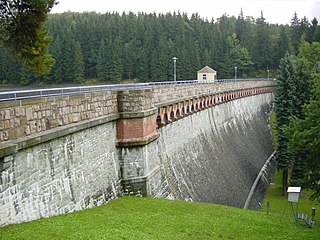
Einsiedel Dam is located in the German Free State of Saxony. Its reservoir supplies drinking water to Chemnitz and, in conjunction with the Central Ore Mountains reservoir system, that includes the reservoirs of Neunzehnhain I, II and Saidenbach also supplies water to the entire region covered by the South Saxony Long Distance Water Association.

The Ore Mountain Toy Museum in Seiffen is an internationally known museum of Ore Mountain toys and Ore Mountain folk art. It was opened in 1953 in Seiffen. In 1973 it was joined by the Ore Mountains Open-Air Museum, a folk art and local historic museum with 14 houses typical of the Ore Mountains before 1900 on the edge of the toy village.

Schwarzenberg Castle was based on a medieval fortification and together with St. George's Church dominates the scene of the large county town of Schwarzenberg in Saxony's district of Erzgebirgskreis.

St. Anne's Church in Annaberg-Buchholz, German Free State of Saxony, is a hall church whose architectural style is on the boundary between the Late Gothic and Renaissance. With a length of 65 metres (213 ft) and width of 40 metres (130 ft), it is the largest, true hall church of the Late Gothic in Saxony. Its tower is 78 metres (256 ft) high, the interior of the church 28 metres (92 ft) high. It is the emblem of the town and visible from a long way off. Saint Anne's was originally built in 1499 as a Roman Catholic church, but became Lutheran in 1539.

The Mettenschicht is an old German mining custom in the Ore Mountains. It is the name given to the last shift worked before Christmas, which ends early with a celebration and meal.
Wolfgang Uhle was a German Lutheran priest, known as "the Plague Pastor of Annaberg".
The lachter was a common unit of length used in the mining industry in Europe, usually to measure depth, tunnel driving and the size of mining fields; it was also used for contract work. In most German-speaking mining fields it was the most important unit of length.
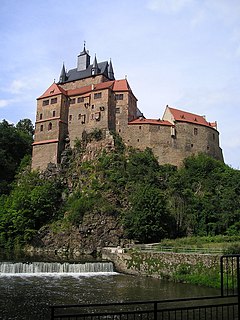
Kriebstein Castle is a castle in Kriebstein near the town of Waldheim in the German state of Saxony.

The Marburger Schloss, also known as Landgrafenschloss Marburg, is a castle in Marburg, Hesse, Germany, located on top of Schlossberg. Built in the 11th century as a fort, it became the first residence of Landgraviate of Hesse (HRE). The Marburg Colloquy was held here in 1529.

Freudenstein Castle is located on the Schloßplatz on the edge of the town centre of Freiberg in the German state of Saxony. Its history is closely linked to the House of Wettin. After several conversions the castle is now a stately home with four wings comprising these buildings: the Langes Haus, Neues Haus, Kirchenflügel, Großer Turm und Schmales Haus.

Lauterbacher Tropfen is a bitters that is manufactured and bottled in the Ore Mountain village of Lauterbach in the borough of Marienberg. The bitters is known for its aromatic taste and dark green colour. The recipe is a company secret. According to the company the spirit is unsweetened.
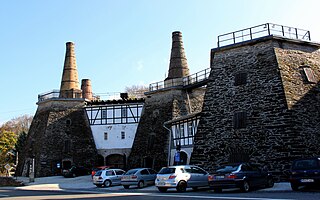
The Lengefeld Lime Works is a limestone mine southwest of Lengefeld in the Saxon town of Pockau-Lengefeld in the Ore Mountains. It is the last mine in Saxony and the last mine on the German side of the Ore Mountains that still transports men and materials into the mine up and down vertical shafts.
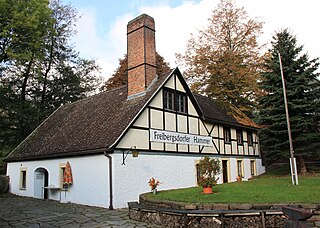
The Freibergsdorf Hammer Mill is an old hammer works that was used for metalworking in the village of Freibergsdorf in the German Ore Mountains. The site represents an important witness to proto-industrial development in the Ore Mountains. Of the once-numerous hammer mills, only three others remain working in Saxony: the Frohnauer Hammer, the Dorfchemnitz Iron Hammer Mill, and the Grünthal Copper Hammer Mill.

The Olbernhau-Grünthal–Deutschneudorf railway, also known as Schweinitztalbahn, was a standard gauge branch line in Saxony from Olbernhau to Deutschneudorf in the Ore Mountains. For a short stretch, it also traversed Bohemia. It was opened in 1927 and closed in 1969.